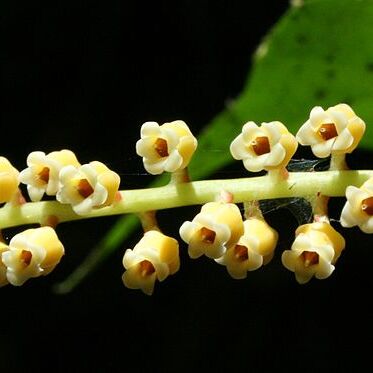Shrubs or small trees. Leaves alternate or apparently opposite, infrequently ternate, the stipules small and deciduous, the blade entire-margined to serrate. Inflorescences axillary or terminal, racemose, paniculate, or sometimes cymose, in-frequently flowers solitary. Flowers small, actinomorphic, the pedicels articulate, bracteolate; sepals free, equal or slightly unequal, ciliolate along the margins, usually persistent; petals imbricate, free, equal or almost so, sessile or very shortly unguiculate, mostly reflexed at the apex, white, yellow, or sometimes red; filaments usually bearing dorsal, erect, carnose, glandular appendages, these adnate only basally or throughout their length to the filaments and often ? united into a tube; anthers free, the connectives dilated dorsally from the base or from the apex into thin, scarious scales (connective scales) exceeding the anthers, the thecae some-times also appendaged; ovary with 3 placentae, each bearing 1-3 or more ovules; style usually erect, the stigma terminal. Capsules loculicidally and elastically 3-valvate, the seeds few, glabrous or pubescent, the endosperm copious and carnose.
Shrubs or small trees, rarely above 20 m. tall. Leaves spirally arranged, rarely opposite or verticillate, usually petiolate, entire or toothed; stipules small but enclosing the terminal bud, caducous. Inflorescence a simple raceme or a compound raceme or thyrse, rarely reduced to a solitary flower; pedicels articulate. Flowers actinomorphic, very rarely slightly zygomorphic. Sepals ± equal, margin often ciliate. Petals ± equal, spreading or reflexed. Stamens free or the filaments wholly or partially united into a tube, with or without a free margin; anthers free with a thin decurrent or non-decurrent prolongation of the connective (connective-appendage), and generally also with 2 free or ± united ventral or thecal appendages. Fruit a loculicidal capsule with 3 contractile valves, each containing 1–several seeds, rarely semisucculent and indehiscent.
Shrubs or small trees. Leaves alternate, rarely opposite (not in Australia), usually acuminate, domatia sometimes present; stipules deciduous, usually conspicuous, often striate. Inflorescence an axillary cyme, fascicle, panicle or solitary flower. Flowers bisexual or unisexual, actinomorphic to slightly zygomorphic. Sepals ± equal to subequal. Petals equal to subequal. Staminal filaments connate or free, very short; anthers connivant, hairy or glabrous; connectives each produced into an entire membranous dorsal appendage, a ventral appendage also sometimes formed. Ovary ovoid to globular; ovules 3–12; stigma filiform, entire or 3-lobed. Fruit a globose, (2) 3-valved capsule, smooth to tuberculate. Seeds usually 3–6 per capsule, globose to obovoid, glabrous or pubescent.
Shrubs or small trees. Leaves alternate, rarely opposite, margin entire or serrate; stipules deciduous. Inflorescences axillary or terminal, racemose, paniculate, or sometimes cymose, rarely flowers solitary. Flowers bisexual, actinomorphic, small. Sepals subequal, leathery. Petals equal or subequal, not spurred. Filaments free or ± connate, inserted inside at top of disk; connectives dilated abaxially from base or from apex into thin, scarious appendages exceeding anthers. Disk circular, slightly 5-lobed. Ovary ovoid, with few or numerous ovules; styles erect; stigmas terminal, not divided. Capsule usually 3-valved, rarely 2-valved. Seeds few, ellipsoid, glabrous or pubescent.
Stamens with filaments simple or bearing an erect dorsal appendage, free or more frequently ± united, when the fused dorsal appendages form a "free margin" to the stamen-tube; anthers free, with a thin dorsal prolongation of the connective ("connective-appendage") and frequently also two free or ± united ventral ("thecal") appendages.
Leaves alternate or, more rarely, opposite or whorled, petiolate, rarely sessile, entire or ± dentate; stipules small, enclosing the terminal bud, deciduous.
Inflorescence simple or compound, cymose or ± racemose, rarely reduced to a single flower, terminal or axillary; pedicels articulated.
Ovary with 3 placentas, each bearing 1–3 or more ovules; style usually erect; stigma terminal.
Fruit a loculicidal capsule with 3 contractile valves, rarely semi-succulent and indehiscent.
Seeds few or one per capsule, usually glabrous and smooth, with abundant fleshy endosperm.
Petals ± equal, often ± reflexed, white or greenish-white to yellow or red.
Flowers actinomorphic or slightly zygomorphic.
Sepals ± equal, margin ciliolate.
Shrubs or small trees.

